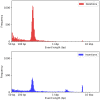Dog10K_Boxer_Tasha_1.0: A Long-Read Assembly of the Dog Reference Genome
- PMID: 34070911
- PMCID: PMC8228171
- DOI: 10.3390/genes12060847
Dog10K_Boxer_Tasha_1.0: A Long-Read Assembly of the Dog Reference Genome
Abstract
The domestic dog has evolved to be an important biomedical model for studies regarding the genetic basis of disease, morphology and behavior. Genetic studies in the dog have relied on a draft reference genome of a purebred female boxer dog named "Tasha" initially published in 2005. Derived from a Sanger whole genome shotgun sequencing approach coupled with limited clone-based sequencing, the initial assembly and subsequent updates have served as the predominant resource for canine genetics for 15 years. While the initial assembly produced a good-quality draft, as with all assemblies produced at the time, it contained gaps, assembly errors and missing sequences, particularly in GC-rich regions, which are found at many promoters and in the first exons of protein-coding genes. Here, we present Dog10K_Boxer_Tasha_1.0, an improved chromosome-level highly contiguous genome assembly of Tasha created with long-read technologies that increases sequence contiguity >100-fold, closes >23,000 gaps of the CanFam3.1 reference assembly and improves gene annotation by identifying >1200 new protein-coding transcripts. The assembly and annotation are available at NCBI under the accession GCF_000002285.5.
Keywords: Canis lupus familiaris; Pacific biosciences; annotation; contiguity; high quality; resource.
Conflict of interest statement
The authors declare no conflict of interest.
Figures




References
-
- Jagannathan V., Drögemüller C., Leeb T., Aguirre G., André C., Bannasch D., Becker D., Davis B., Ekenstedt K., Faller K., et al. A comprehensive biomedical variant catalogue based on whole genome sequences of 582 dogs and eight wolves. Anim. Genet. 2019;50:695–704. doi: 10.1111/age.12834. - DOI - PMC - PubMed
-
- Dermitzakis E.T., Kirkness E., Schwarz S., Birney E., Reymond A., Antonarakis S.E. Comparison of human chromosome 21 conserved nongenic sequences (CNGs) with the mouse and dog genomes shows that their selective constraint is independent of their genic environment. Genome Res. 2004;14:852–859. doi: 10.1101/gr.1934904. - DOI - PMC - PubMed
Publication types
MeSH terms
Grants and funding
LinkOut - more resources
Full Text Sources
Other Literature Sources
Miscellaneous

